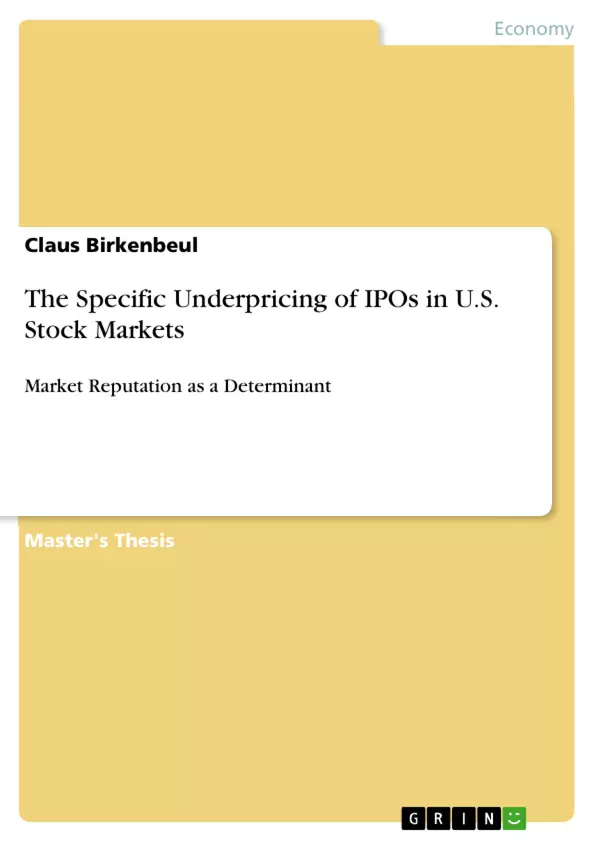The economical development is improving and world trade volumes are expected to recover. The recorvery process is developing constantly but slowly: Share prices have rebounded within 2009, worldwide trade volumes have recovered slightly and are expected to catch up with values from the end of 2008 during the next year (cf. OECD 2009).
The world is recovering from one of the most severe economic downturns since The Great Depression. Comparing GDP volumes from the previous period at the same time, OECD countries lost up to 2%.
As a logical consequence the U.S. IPO market has been affected by the economic meltdown as well. "IPO activity tends to cluster in certain time periods, thus it appears in waves, so-called hot IPO markets" (Hamer 2007, 9). From 2007 to 2008 th e number of IPOs decreased. The U.S. market broke down by more than 85% in one year. In 2007 there were 160 IPOs whereas in 2008 21 securities went public fort the first time (cf. Ritter 2010, 2). After the slowest year for IPOs since the 1970s, the market began to show signs of life again in 2009. The number of offerings increased by 21% although the offering value decreased by almost 15% (cf. PWC 2010). [...]
Inhaltsverzeichnis (Table of Contents)
- INTRODUCTION
- INITIAL PUBLIC OFFERINGS AND THEIR UNDERPRICING
- THE IPO
- GOING PUBLIC IN THE U.S.
- THE IPO PROCESS - PREPARATION AND FACTORS OF SUCCESS
- PARTICIPANTS AND THEIR ROLES
- IPO UNDERPRICING
- DEFINITION
- WHO BENEFITS FROM IPO UNDERPRICING?
- EVIDENCE ON UNDERPRICING
- THE REPUTATION OF MARKET SEGMENTS IN THE CONTEXT OF IPO UNDERPRICING
- MARKET SEGMENTATION IN THE UNITED STATES
- THE REPUTATION OF MARKET SEGMENTS
- LISTING REQUIREMENTS IN THE U.S. AND THEIR POTENTIAL IMPACT ON MARKET REPUTATION
- THE SEC AND ITS REQUIREMENTS
- INITIAL REGISTRATION
- PERIODICAL REQUIREMENTS
- LISTING REQUIREMENTS AT NYSE EURONEXT MARKETS
- INTRODUCTION TO NYSE EURONEXT
- CORPORATE GOVERNANCE
- NEW YORK STOCK EXCHANGE
- ARCA
- AMEX
- LISTING REQUIREMENTS AT NASDAQ OMX MARKETS
- INTRODUCTION TO THE NASDAQ OMX GROUP
- CORPORATE GOVERNANCE
- THE GLOBAL SELECT MARKET
- THE GLOBAL MARKET
- THE CAPITAL MARKET
- COMPARISON AND POSSIBLE IMPLICATIONS ON THE UNDERPRICING
- THE SEC AND ITS REQUIREMENTS
- EMPIRICAL ANALYSIS
- DATA BASE AND METHODOLOGY
- SAMPLE DESCRIPTION
- THE SPECIFIC UNDERPRICING IN EACH MARKET SEGMENT
- THE UNDERPRICING AT NYSE EURONEXT AND NASDAQ OMX MARKET SEGMENTS - AN AGGREGATED COMPARISON
- REGRESSION ANALYSIS
- THE REGRESSION MODELS
- RESULTS AND DISCUSSION
- SUMMARY OF THE EMPIRICAL ANALYSIS
- CONCLUSION
Zielsetzung und Themenschwerpunkte (Objectives and Key Themes)
This study examines the specific underpricing of initial public offerings (IPOs) in U.S. stock markets and investigates the role of market reputation as a determinant. It explores the IPO process, the benefits of underpricing, and the evidence of underpricing in different market segments. The study analyzes the specific underpricing in each market segment, compares the underpricing at NYSE Euronext and Nasdaq OMX market segments, and conducts regression analysis to evaluate the relationship between underpricing and company performance. The study focuses on the listing requirements of the U.S. Securities and Exchange Commission (SEC) and the different market segments in the United States, aiming to provide insights into how market reputation influences IPO underpricing.
- The underpricing of initial public offerings (IPOs) in U.S. stock markets
- Market reputation as a determinant of IPO underpricing
- The specific underpricing in each market segment
- The role of listing requirements and regulations
- Empirical analysis of the relationship between underpricing and company performance
Zusammenfassung der Kapitel (Chapter Summaries)
The first chapter provides an introduction to the study, outlining its objectives and scope. The second chapter delves into the concept of initial public offerings (IPOs), their underpricing, and the reasons behind it. It explores the IPO process in the United States, the different participants involved, and the potential benefits of underpricing. Chapter three examines the concept of market reputation in the context of IPO underpricing. It discusses market segmentation in the United States and explores the different reputation levels associated with various market segments. Chapter four focuses on listing requirements in the U.S. and their potential impact on market reputation. It examines the regulations imposed by the Securities and Exchange Commission (SEC) and the listing requirements of NYSE Euronext and Nasdaq OMX markets. Chapter five presents the empirical analysis of the study. It describes the data used and the methodology employed, including the sample description, the specific underpricing in each market segment, and the comparison of underpricing at NYSE Euronext and Nasdaq OMX market segments. Finally, the chapter conducts regression analysis to investigate the relationship between underpricing and company performance.
Schlüsselwörter (Keywords)
Initial Public Offerings (IPOs), underpricing, market reputation, market segmentation, listing requirements, U.S. Securities and Exchange Commission (SEC), NYSE Euronext, Nasdaq OMX, regression analysis, company performance.
- Quote paper
- Claus Birkenbeul (Author), 2010, The Specific Underpricing of IPOs in U.S. Stock Markets, Munich, GRIN Verlag, https://www.grin.com/document/158711



